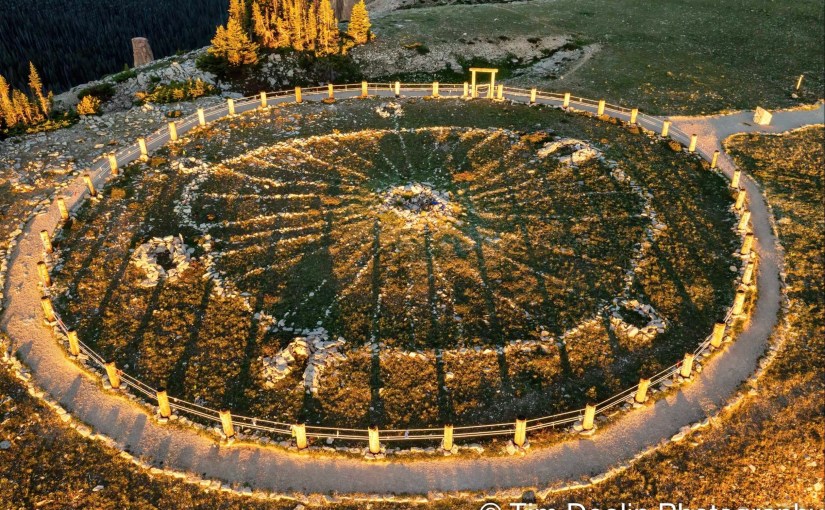The Medicine Wheel of Wyoming: A Sacred Place and Enigmatic Landmark
In the rugged and majestic landscapes of the Bighorn Mountains in Wyoming, stands a remarkable and enigmatic structure known as the Medicine Wheel. This ancient stone circle, dating back centuries, is a testament to the ingenuity, spirituality, and astronomical knowledge of the Indigenous peoples who once inhabited this region. The Medicine Wheel is not just a physical monument; it is a sacred site, a place of pilgrimage, and a source of profound spiritual significance for many Native American tribes. Its mysterious origins, intricate design, and enduring legacy have captivated researchers, historians, and visitors from around the world.
A Glimpse into History
The exact origins of the Medicine Wheel are shrouded in mystery. However, archaeological evidence suggests that the structure was likely constructed sometime between 1200 and 1700 CE. The tribes most closely associated with the Medicine Wheel include the Crow, Cheyenne, Lakota, and Shoshone, although its use and significance likely extended to other Indigenous groups in the area.
The construction of the Medicine Wheel involved the careful arrangement of hundreds of stones, forming a circular pattern with radiating spokes. The wheel itself is approximately 80 feet in diameter, with the central cairn (a pile of stones) at the center. From the central cairn, 28 spokes radiate outwards, creating a design that resembles a wagon wheel or a spiderweb. At specific points around the circumference of the circle, smaller cairns are located, adding to the complexity of the structure.
Spiritual Significance
The Medicine Wheel holds deep spiritual significance for Native American tribes. It is believed to be a sacred place, a conduit to the spiritual realm, and a site for ceremonies, rituals, and personal reflection. The circle itself represents the cyclical nature of life, death, and rebirth, as well as the interconnectedness of all things. The spokes are often interpreted as representing the directions, the seasons, or the different stages of life.
The central cairn is often seen as the place of origin, the heart of the universe, or the connection to the Creator. The smaller cairns may represent specific stars, celestial bodies, or significant events. The Medicine Wheel is also associated with the concept of balance and harmony. It is a place where individuals can seek guidance, healing, and spiritual growth.
Astronomical Interpretations
One of the most fascinating aspects of the Medicine Wheel is its potential astronomical alignment. Researchers have suggested that the structure may have been used as an astronomical observatory, allowing the Indigenous peoples to track the movements of celestial bodies.
Certain features of the Medicine Wheel align with significant astronomical events, such as the summer solstice sunrise and the rising and setting of specific stars. The alignment of the Medicine Wheel with the summer solstice suggests that the structure was used to mark the passage of time and to celebrate the change of seasons. The alignment with specific stars may have been used to predict planting times, hunting patterns, or to understand the cyclical nature of the cosmos.
Theories and Interpretations
Over the years, numerous theories and interpretations have emerged regarding the purpose and meaning of the Medicine Wheel. Some researchers believe that the structure was used for ceremonies, such as vision quests, sweat lodge ceremonies, or sun dances. Others suggest that the Medicine Wheel was a place of healing, where individuals could connect with the spiritual realm and seek guidance.
Other theories propose that the Medicine Wheel was used for astronomical observation, agricultural planning, or as a calendar. It is likely that the Medicine Wheel served multiple purposes and held different meanings for different tribes and individuals.
Preservation and Respect
The Medicine Wheel is a fragile and irreplaceable cultural treasure. It is essential to protect and preserve this sacred site for future generations. The Medicine Wheel is located on public lands, and it is managed by the U.S. Forest Service. The agency works in partnership with Native American tribes to ensure that the site is protected and that its cultural significance is respected.
Visitors to the Medicine Wheel are encouraged to approach the site with respect and reverence. It is important to avoid disturbing the stones, walking on the structure, or removing any artifacts. Visitors are also encouraged to learn about the history and significance of the Medicine Wheel and to understand its cultural importance to Native American tribes.
Visiting the Medicine Wheel
The Medicine Wheel is located in the Bighorn National Forest in Wyoming, approximately 40 miles east of Lovell. The site is accessible by a gravel road, and the road is usually open from late spring to early fall, depending on weather conditions. Visitors are advised to check road conditions and weather forecasts before planning a trip.
The Medicine Wheel is a remote and isolated site, and visitors should be prepared for changing weather conditions and limited amenities. There are no facilities at the site, so visitors should bring their own food, water, and supplies.
A Legacy of Wisdom and Wonder
The Medicine Wheel of Wyoming stands as a testament to the rich cultural heritage of the Indigenous peoples of North America. It is a place of profound spiritual significance, astronomical knowledge, and enduring mystery. As visitors journey to this sacred site, they have the opportunity to connect with the past, to reflect on the present, and to contemplate the wonders of the universe. The Medicine Wheel is a legacy of wisdom and wonder, a reminder of the enduring power of human creativity, spirituality, and connection to the natural world.



